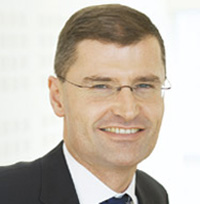|

Ditlev Engel,
President of Vestas
Class of 2008
During the past few years, Vestas has experienced a tremendous growth. 80,000 shareholders have invested in the world’s largest wind turbine manufacturer. According to President and CEO Ditlev Engel, Vestas is only just starting its transformation. The company has raised its product quality, and receives new orders every week. At the end of 2006 Vestas had a market share of 28 per cent – on a market with an expected growth rate of at least 15-20 per cent a year over the next decade.
The world-wide demand for energy is increasing, conventional energy resources are declining and the use of fossil fuels threatens drastically climate change. Wind power is today a mainstream, high-tech, competitive and extremely reliable generating technology. Therefore, wind energy has become an important player in the world’s energy markets.
According to Ditlev Engel, wind power is today the leading modern form of energy because it is competitive with conventional power plants in terms of costs, because wind is a local source of power that reduces reliance on imported energy, because wind power can be installed quickly and, finally, because wind power saves the environment millions of tons of CO2.
Modern Energy
In August 2007, at Vestas’ quarterly presentation of accounts broadcast from London in the United Kingdom, Ditlev Engel presented a new strategy for the company: Vestas as No. 1 in Modern Energy. An international information campaign is aimed at putting wind power at the top of the global energy agenda, where the political targets in many countries have already been identified.
Vestas has built production facilities in more than 12 countries and is currently expanding and opening up new production facilities in China, Spain and USA in order to be close to customers and to satisfy the market needs. Based on the ongoing global developments that may directly or indirectly affect the wind market, Vestas does foresee a significant strengthening of the wind energy sector and Vestas as the company being No.1 in Modern Energy in the years to come.
“Since 2001, Vestas has continuously been hiring new highly-skilled employees to handle the increasing demand. In 2001, Vestas had approximately 5,200 employees and by the end of 2007, there were around 15,500 employees from 42 different nationalities working at more than 50 locations. What is more, by the end of 2008, we expect to have increased our headcount to up to 18,000 employees,” explains Engel.
Vestas has installed over 33,500 wind turbines in 63 countries on five continents. During the last 25 years, the capacity of Vestas wind turbines has grown 100-fold, from 30 kW to 3 MW. 1/3 of all wind turbines installed worldwide are Vestas turbines.
US to be the largest market for wind energy in 2009
In terms of economic value, the global wind market is estimated to be worth about 36bn US Dollars per year in new generating equipment – and this figure is expected to increase significantly in the years to come. In 2007, the US more than doubled the 2006 figure for new wind power installations.
The North American market has during the past two years experienced the largest growth worldwide. The Global Wind Energy Council stated in 2006 that the US was predicted to be the most important global market for wind power in the world during the period 2007–2010 with an average growth of 3,500 MW per year. It can be expected that the US will overtake Germany as the largest market for wind energy by the end of 2009, provided that growth continues at the current rate.
The vision of wind is realistic
Vestas’ goal is that at least 10 per cent of the world’s power production should be based on wind energy by 2020. To achieve this, the wind turbine industry must install a total of around 1,000,000 MW over the next 13 years. Today, the global share of wind energy is less than 1 percent of the worldwide electricity demand. If this goal is reached, wind power as a single energy source will account for 15 percent of the CO2 reduction requirement for 2020 set forth by the United Nations Framework Convention on Climate Change (UNFCCC).
“This is a golden opportunity to tell the world about the advantages of wind power. The whole wind power industry has been very weak at putting its message across. We don't want wind power to be seen as a peripheral, alternative energy source. Wind is eternal,” says Ditlev Engel.
|

